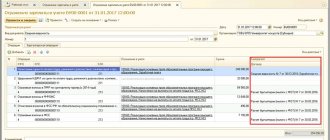What is the frequency of inventory of financial obligations in a budget institution?
Financial and other obligations of the institution must be verified as part of the inventory (clause 9 of the Instructions for reporting, approved by order of the Ministry of Finance of Russia dated March 25, 2011 No. 33n, clauses 80-81 of the federal accounting standard for public sector organizations “Conceptual framework for accounting and reporting of public sector organizations sector", approved by order of the Ministry of Finance of the Russian Federation dated December 31, 2016 No. 256n, clause 27 of the Regulations on accounting, approved by order of the Ministry of Finance of the Russian Federation dated July 29, 1998 No. 34n):
- on the grounds, within the time frame and in the manner established by the accounting entity as part of the formation of its accounting policy;
- when establishing facts of theft or abuse, as well as damage to property;
- in the event of a natural disaster, fire, accident or other emergency, including those caused by extreme conditions;
- when changing financially responsible persons (on the day of acceptance and transfer of cases);
- when transferring (returning) a complex of accounting objects (property complex) for rent, management, free use, storage, as well as when purchasing or selling a complex of accounting objects (property complex);
- in other cases provided for by law and regulations;
- when preparing annual reports;
- during reorganization or liquidation of an institution.
The institution has the right to determine in local legal acts that establish the inventory procedure, in accordance with clause 6 of the Instructions, approved by Order of the Ministry of Finance of the Russian Federation dated December 1, 2010 No. 157n, additional grounds for carrying out the corresponding procedure.
The procedure for conducting an inventory is usually part of the accounting policy of the institution. You can see a sample accounting policy in ConsultantPlus. If you are not yet registered in the system, get trial online access for free.
If the institution is autonomous or budgetary, the inventory in it should be carried out as of July 1, October 1, January 1 of the year following the reporting year, since in accordance with paragraph 69 of the Instruction approved by Order of the Ministry of Finance No. 33n, these organizations must be provided to the manager information on debts (form 0503769), which, in turn, are identified during the inventory.
Inventory of property and financial obligations: preparation and documentation
The need to conduct inventories is provided for in Art. Law “On Accounting” dated December 6, 2011 No. 402-FZ. The rules for conducting an inventory of property and financial obligations are established by the Methodological Instructions approved by Order of the Ministry of Finance dated June 13, 1995 No.
All assets and liabilities of the company are subject to routine inspection.
The property includes:
- OS and intangible assets;
- financial investments;
- industrial reserves – materials, fuel, raw materials;
- finished products;
- goods;
- inventory;
- money and other assets.
The company's liabilities are usually represented by:
- debt to creditors - suppliers, budget, banks, personnel, funds;
- accounts receivable;
- formed reserves.
Read also: The procedure for taking inventory of receivables and payables
The procedure and timing of the inventory of property and financial obligations is established by the head of the company, except for situations when an audit is carried out initiated by investigative authorities, higher organizations, etc. Inventories carried out before compiling annual accounting reports, as well as for any reason, are considered mandatory - for example, when there is a change in financially responsible employees, abuse of responsible persons or officials, when transferring assets for rent or when selling them, after natural disasters or theft.
The inventory procedure begins with the manager’s order (inventory order), in which:
- a list of types of property subject to inventory is determined;
- an inventory commission is appointed listing the positions and full names of those involved (for each group of assets or settlements being inspected). Such permanent commissions are created at the enterprise by order of the administration; they include specialists from different departments - technologists, financiers, engineers, and, if necessary, independent auditors. When conducting an inventory, the presence of all members of the commission is mandatory;
- the circle of persons responsible for registration and preparation of inventory documents is determined;
- deadlines are set for conducting inspections and presenting documented results.
An inventory of any assets is preceded by the determination of their accounting balances as of the date of inspection. The inventory procedure is a comparison of available assets with accounting data.
What is the algorithm for inventorying financial obligations in budget structures?
The algorithm for inventorying the financial liabilities of an institution will generally be similar to what characterizes the inventory of any other liabilities, as well as assets of a business entity. It involves the implementation of the procedure under consideration within the following stages:
- Issuance of an order by the management of the institution to conduct an inventory.
For this purpose, the unified form INV-22 is used, approved by Resolution of the State Statistics Committee of the Russian Federation dated August 18, 1998 No. 88.
Test yourself: how to take an inventory. Completion time: about 5 minutes. Take the test
The order in question also approves the inventory commission - the internal structure of the budgetary institution, without which the inventory cannot be carried out.
If the institution is budgetary or autonomous, it makes sense to form a permanent commission that has the appropriate powers, since these institutions are expected to regularly, as we noted above, once a quarter, submit reports to the manager based on data obtained, including during the inventory.
- Reflection of order information in the journal.
This journal is also compiled using a unified source - INV-23.
- Execution of receipts by financially responsible persons (hereinafter referred to as MOL).
As a rule, these receipts are included in the structure of unified inventory records, the use of which is expected at the next stage. But if this is not the case, these receipts can be drawn up in free form.
- Filling out unified inventory lists and other documents - for example, matching statements based on the results of studying accounting documents that reflect the institution’s financial obligations.
In this case, we are talking about filling out at least:
- inventory according to form 0504083 (inventory of loan debts), approved in Appendix No. 1 to Order of the Ministry of Finance of Russia dated March 30, 2015 No. 52n;
- inventory according to form 0504089, also approved by Order No. 52n (inventory of settlements with buyers and suppliers).
It can be noted that the structure of both forms contains formulations that, from a legal point of view, are similar to those that can be given in MOL receipts.
If the institution is budgetary or autonomous, then it must, as we noted at the beginning of the article, also fill out form 0503769 according to order No. 33n as of July 1, October 1, January 1 of the year following the reporting year.
In addition, other inventories may be compiled as provided for by the local regulations of the institution that regulate inventory.
- Filling out reporting documents:
- by all institutions - an act of reconciliation of mutual settlements with counterparties to whom the institution has financial obligations (according to the unified form INV-17);
- budgetary and autonomous institutions - information on conducting inventories in the form of Table No. 6 according to Order No. 33n.
Let's take a closer look at working with these forms.
Inventory of the organization's assets and liabilities
The purpose of regular inspections, recalculation of property, and identification of the exact amounts of liabilities is to ensure the reliability of the company’s accounting and reporting. During the audit, the actual availability of property and the assessment of liabilities, compliance with accounting data are checked.
The obligation to carry out inventories is established by Art. Law “On Accounting” dated December 6, 2011 No. 402-FZ, and the main instructions for the inventory of assets and liabilities, regulating the algorithm for conducting an audit, are “Guidelines for the inventory of property and liabilities”, approved by Order of the Ministry of Finance No. dated June 13, 1995 (as amended by 08.11.2010). The accounting forms for the audit results are approved by Resolution of the State Statistics Committee of the Russian Federation dated 08/18/1998 No. (as amended on 05/03/2000) - these are forms with the abbreviation “INV”. Although unified forms have been optional since 2013, many companies use them. If standard forms are not used for inventory results, the company will have to develop and approve its own forms, taking into account all the required details.
Another regulatory document is the “Regulations on accounting and reporting”, approved. by order of the Ministry of Finance No. 34n dated July 29, 1998 (as amended on April 11, 2018). The procedure, timing of audits, and the list of the company’s property being inspected are approved directly by its director. According to clause of this Regulation, inventory must be carried out at least once a year before summing up the annual results and submitting annual reports. An exception may be made for:
- fixed assets: they are checked once every 3 years;
- library collections - checked once every 5 years;
- property inventoried between October 1 and December 31 of the reporting year.
There are also cases of unscheduled mandatory inventory:
- when changing materially responsible employees;
- upon detection of facts of theft, intentional damage to assets, or abuse of them;
- in case of natural disasters;
- during reorganization and liquidation of the company;
- in other cases: for example, when selling a company as a whole property complex (Article 561 of the Civil Code of the Russian Federation).
The inventory of receivables and payables should be carried out as of December 31 of the current year (inclusive), this is stated in the Letter of the Ministry of Finance No. 07-02-18/01 dated 01/09/2013.
Inventory of financial obligations: filling out forms INV-22 and INV-23
So, the first stage of inventorying the financial obligations of an institution is drawing up an order to conduct the appropriate inventory using the unified form INV-22. In this case, it is fundamentally important to reflect in the document:
- lists of specific obligations that are subject to inventory;
- the reason for the inventory (it may reflect the specifics of business transactions with liabilities - for example, if the creditor sent the institution a claim with inflated figures, and this became the reason for initiating an inventory of liabilities).
Otherwise, the document is filled out in the same way as in the case of an inventory of any other liability or asset. It is necessary to correctly reflect the data on the composition of the commission and ensure that the document is certified by the head.
You can learn more about the specifics of filling out the INV-22 form in the article:
.
Information about the order to conduct an inventory must be reflected in the journal, which is compiled on the basis of another unified form - INV-23. It is also important in this source to reflect the list of specific obligations that are verified as part of the inventory. Otherwise, filling out the appropriate form follows the general rules.
You can learn more about the features of filling out the INV-23 form in the article:
“Unified form No. INV-23 - form and sample”.
Inventory of calculations with the budget in 1C: Accounting ed. 3.0
Published 02/19/2020 16:51 Author: Administrator We continue the series of publications on conducting an inventory of property and liabilities in organizations. And today’s article will be devoted to an inventory of settlements with the budget and extra-budgetary funds.
In the 1C program: Accounting ed. 3.0 there are no special documents provided for conducting an inventory of settlements with the budget. But as in the case of inventory of goods and materials, you need to start the procedure by issuing an order. To do this, create a new document “Calculation Inventory Act”, which can be found in the Purchases/Sales sections. Next, we proceed by analogy with the inventory of goods and materials.
First of all, you need to fill out the “Inventory” and “Inventory Commission” tabs:
We print out form INV-22 “Order to conduct an inventory” and give it to all participants against signature (for more information on how to do this, read the article Inventory of goods and materials in 1C: Accounting). After this, we proceed directly to the inventory itself.
Here you should understand that the data on the balances of the budget settlement accounts (account 68 and account 69) in the program will not correspond to the information provided to you at the request of the Federal Tax Service and the funds. This is due to the fact that data on tax accruals and contributions will appear in your personal accounts no earlier than you submit the corresponding tax returns and calculations. Therefore, for inventory, you need to take information on balances from the Federal Tax Service and funds as of the date close to the reporting date, requesting a reconciliation from them. Tax officials and funds will reconcile calculations based on the application from the organization.
An application for reconciliation can be submitted to the tax office in person, by mail or through your personal account on the Federal Tax Service website. If you use the 1C-Reporting service, then you can request various types of reconciliations directly from the program via telecommunication channels (TCS). To do this, go to the “Reports” section, then “Regulated reports”. On the “Reconciliation” tab we are interested in the “Request reconciliation” button.
When submitting an application in person to the Federal Tax Service, the taxpayer will receive a reconciliation report within five days (approved by Order of the Federal Tax Service dated December 16, 2016 No. ММВ-7-17/ [email protected] ). The organization's accountant will verify the data in the report. If there are no disagreements, he will sign it and send it back.
If a request for reconciliation is sent via TKS, the tax authorities will send a reconciliation report for information. There is no need to sign it and return it to the tax authorities (clause 2.22 of Appendix No. 1 to the Federal Tax Service order dated June 13, 2013 No. MMV-7-6 / [email protected] ). If the organization finds discrepancies in the act, it will submit a paper application to the inspectorate. If upon receipt of the act the company does not agree with it, it will do so in column 4 of section. 1 act will indicate its amounts. After this, inspectors will check the data in their database.
When discrepancies arose due to an error by the Federal Tax Service, the inspectors must eliminate it (clauses 3.1.5, 3.1.6 of the regulations, approved by order of the Federal Tax Service dated 09.09.2005 No. SAE-3-01 / [email protected] ). If discrepancies arise due to your error, then the Federal Tax Service will notify you of this by sending a notification in which it will indicate which error led to the discrepancy in data (clause 3.4.6 of the Federal Tax Service Regulations). The organization must reflect its data in the column “Data of the interested party” in section. 2 acts and write a request in free form indicating the reasons for the error and a request to correct it. Together with copies of supporting documents, submit all this to the inspection. The controllers will re-check the information, correct errors and issue a new section. 1 subject to changes.
IMPORTANT! The presence of a statement of reconciliation of calculations without the presentation of primary documents (payment orders, initial and updated declarations) cannot serve as evidence of excessive tax payment.
After you have a signed reconciliation report in your hands, you need to draw up additional certificates and calculations that will confirm the amounts of balances as of December 31 reflected in the accounting:
As mentioned above, in the standard 1C: Accounting ed. 3.0 does not provide for the generation of the INV-17 form and a certificate for the INV-17 act for accounts 68 and 69. Therefore, they will have to be filled out manually.
For your convenience, you can download the above document forms here:
Help for INV 17 act
Inv-17
First, fill out the Certificate for Form INV-17. It reflects in detail the data of the debtor/creditor and the “debt history”: why the debt arose, details of the document that created the debt:
The data specified in the certificate is confirmed by acts of reconciliation with the budget and extra-budgetary funds and other primary documents justifying the amount of debt.
Then we transfer the data from the certificate in compressed form into the act:
Printed documents are signed by members of the inventory commission.
Author of the article: Anna Kulikova
Did you like the article? Subscribe to the newsletter for new materials
Add a comment
JComments
Inventory of financial obligations: inventories
The document in question is used to reflect the results of the inventory of the institution’s debts to counterparties in accordance with accounting information. Form 0504083 allows you to reflect, in particular:
- the amount of debt - in general, by principal, interest;
- the amount of unpaid interest, penalties, penalties;
- confirmed and unconfirmed amounts of debts;
- overdue debt.
The document in question must be signed by the head of the inventory commission and all its representatives.
The next important document when inventorying an institution’s financial obligations is an inventory of settlements with counterparties in form 0504089. It records:
- information about the institution’s debts (due, in particular, to obligations under civil contracts);
- information about counterparties;
- amounts of debt classified on various grounds;
- confirmed and unconfirmed debts;
- amounts with an expired statute of limitations.
Similarly, the document under consideration is signed by the head of the commission and its members.
Information on the debt of budgetary and autonomous institutions
Budgetary and autonomous institutions fill out at the appropriate stage of the inventory information about the institution’s debt in form 0503769. This document records:
- data on accounts receivable and payable;
- data on overdue debts;
- analytical information on the movement of both types of debts.
It can be noted that the form in question is used as part of the inventory of financial obligations, primarily in order to certify the correctness of the institution’s use of budget funds. If form 0503769 reflects debts not provided for by the contract or their amount exceeds that provided for in the contract, the manager of budget funds will certainly have questions for the management of the institution.
Reconciliation report with counterparties
The corresponding act is filled out based on the information reflected in the inventories of debts discussed above.
The main purpose of its preparation is to obtain confirmation of the current status of the debt from the counterparty.
In addition, the act is useful from the point of view of:
- identifying errors in accounting for the institution’s financial obligations;
- reflecting the absence of disagreements regarding debts on the part of the counterparty;
It is mandatory to draw up the relevant document in 2 copies, subject to both being signed by competent representatives of the institution, as well as representatives of the counterparty.
The signed act may be the basis for initiating debt collection from the obligated party in court.
You can familiarize yourself with the procedure for filling out the INV-17 form in the article “Unified form No. INV-17 - form and sample” .
Information about inventories according to table No. 6
Budgetary and autonomous institutions draw up another reporting document - table No. 6 “Information on conducting inventories” according to order No. 33n. It reflects information on the results of inventories of the institution’s obligations carried out within the reporting period.
Columns 1–4 of Table No. 6 reflect the reasons for initiating the inventory, the date of its implementation, as well as the details of the order for its implementation.
Columns 5 and 6 record discrepancies between inventory results and accounting information.
Column 7 indicates a list of measures taken by institutions to eliminate detected discrepancies.
Table No. 6 is provided to the manager of budget funds once a year.
Results
Financial obligations of a budgetary institution to borrowers and counterparties are reflected in accounting documents and are periodically subject to verification as part of the inventory. To certify various types of financial obligations, unified forms are used, approved by orders of the Ministry of Finance of Russia No. 33n (in its jurisdiction - budgetary and autonomous institutions) and No. 52n (in its jurisdiction - all government institutions, including government ones). The ultimate goal of conducting an inventory of relevant obligations is to provide the manager with information reflecting the facts of the correct receipt and expenditure of funds by the budgetary institution.
You can find other information about the inventory of obligations in the articles:
- “Inventory of receivables and payables”;
- “Inventory of settlements with accountable persons (nuances)”.
You can find more complete information on the topic in ConsultantPlus. Free trial access to the system for 2 days.
The procedure for taking inventory of assets and liabilities
The inventory procedure is quite complex, capacious and requires a considerable amount of working time. It is carried out in several successive stages.
Stage 1. Creation of an inspection commission
Members of the commission are appointed by order of the head (usually in the INV-22 form); they can be specialists from various departments, not just accounting: economists, engineers, managers, technicians, administrators, etc. The commission may also include expert employees of an independent specialized auditing firm. When the inventory begins, a special order is issued, which lists the property and liabilities to be verified, as well as the start date and timing.
Stage 2. Actual inventory of assets and liabilities
During the inventory, 100% presence of all members of the commission is necessary, otherwise the results of the inspection are considered invalid. Verification of tangible assets occurs by actually recalculating them, weighing them, measuring them, and recording the obtained data in inventory records. The presence of financially responsible persons is strictly necessary.
Inventory of property that does not have a material form (intangible assets, RBP, financial investments, etc.) is carried out by inspecting and verifying available documents confirming the company’s rights to these assets (clauses 3.8, 3.14 of the Methodological Instructions). The correctness of assigning each asset to a given group of property and monthly write-offs of the value for current expenses are also checked.
Inventory of liabilities includes checking accounts receivable/payable and the validity of the amounts reflected in the accounting accounts. The correctness of the reflected amounts is confirmed by reconciliation acts with the company’s counterparties and with government inspection bodies (IFTS, Social Insurance Fund, etc.). The verification begins with drawing up a certificate of debts listed in accounting: for this it is recommended to use the Appendix to form INV-17 “Inventory report of settlements with suppliers, buyers and other debtors and creditors.” Coordination of debt amounts to counterparties is carried out by drawing up and mutually signing reconciliation reports. From the moment the reconciliation acts are signed, the limitation period begins to count according to Art. 203 of the Civil Code, therefore, based on the results of the inventory, debts with an expired statute of limitations can be written off as financial results.
Reconciliation with the budget and funds is carried out on the basis of acts of reconciliation of calculations and certificates of debt status.
Inventory of calculations also includes checking accruals and payments of wages, benefits, financial assistance to personnel, and the presence of deposited or overpaid amounts. Accountable funds issued to employees, as well as supporting primary documents provided by them, are also subject to verification.
Stage 3. Presentation of results.
Data on the actual availability of tangible and intangible assets, as well as the amounts of recorded liabilities, are recorded in inventory records and acts. They are drawn up in at least 2 copies and certified by the signatures of each participant in the inspection. There should be no empty lines in these documents; if there is no data, the line is crossed out.
Detected deviations are recorded in comparison sheets. The amounts of detected shortages or, conversely, surpluses of valuables are assessed according to their value in the company’s accounting records. The decision to write off shortages and credit surpluses is made by the head of the company.
Data from the verification of all assets and liabilities are summarized in the general Statement of the INV-26 form.
Documents for checking mutual settlements and obligations during the annual audit are dated December 31. All results of the annual inventory are reflected in the annual financial statements of the current year being audited, and when checking within the year, in the data of the reporting period when the inventory was carried out. You can find more complete information on the topic in ConsultantPlus. Free trial access to the system for 2 days.






